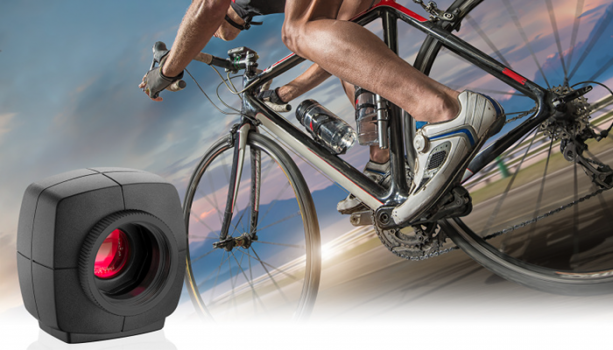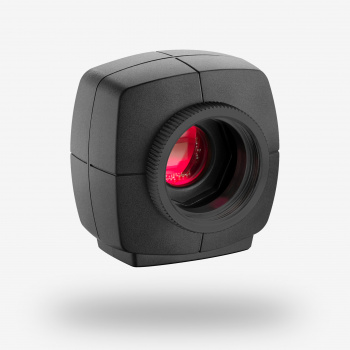Success in the Saddle

Description
By: Silke Von Gemmingen, IDS Imaging Development Systems GmbH
Cycling is a popular sport. Under exertion, however, it exposes the body to considerable mechanical stress: 10 hours of cycling means 54,000 pedal strokes and as many bends of the knee, hip, postural muscles, and joint restrictions. The repetitive movement of pedaling places great demands on tendons and joints. This can lead to functional and biomechanical dysfunctions and thus be the cause of pain and injuries, combined with a drop in performance and training standstill.
According to a study (Clarsen Krosshaug, 2010), professional cyclists often complain of pain, especially in the back (85%) or in the knees (57%). In addition to avoiding pain or even injuries, any increase in performance plays a major role in professional sport. The most diverse bike fitting methods are now used to adapt the bike to the individual needs of the athlete.
The French bike fitting specialist AR-Entraînement focuses primarily on the evaluation of the specific performance requirements and physical abilities of the individual cyclists. This is because every cyclist has different requirements, both in terms of physical conditions such as body size, lever length of the extremities or weight, and in terms of physical and coordinative abilities, such as mobility. In collaboration with the professional racing bike team Vital Concept B&B Hotels, AR-Entraînement has developed an analysis system that is used primarily in their performance center.
The bike fitting specialist combines static, dynamic, and perceptive analysis methods. "The system is based on practical experience and exchanges with fitness trainers, osteopaths, and doctors from the world of cycling, on the theoretical examination of scientific findings and on common sense," explains Managing Director Alban Renaud.
For analysis, the professional's bicycle is fixed in a roller trainer. An IDS camera is positioned exactly parallel to the bike and rider to record this set in a two-dimensional X-Y axis. While the cyclist pedals with different intensity and in different positions, the camera captures the motion sequence. In high quality and with high frequency (60fps) changes of the joint angles are recorded exactly and without any distortion. The IDS camera, connected to a powerful laptop via USB 3.0, transfers the data using free motion analysis software.
The direct effects on the respective mechanical parameters of the rider are measured, i.e. the influence of force, movement, and pedal technology. Movement-related deformations are taken into account because the pedal movement is not simply pedaling in a circle: The joint angles of the riders show deviations of up to 15-deg. The resulting constantly changing effect on the entire body influences the overall efficiency of pedaling.

Figure 1: Frontal Analysis allows the kinematics of the lower extremities to be identified during pedaling.
The "Kinovea" software detects the IDS camera as soon as the cyclist package of the IDS Software Suite is installed. It allows manual measurement of angles, distances, and times, as well as semi-automatic tracking to trace trajectories of points in the video. The timeline allows the user to move forwards or backwards at the desired speed or frame by frame to stop at the right time and to highlight the elements in question. The images can be enlarged up to 6 times. Alignment or connection angles can be measured on the selected image to evaluate the respective wheel settings. Depending on the measurement data, adjustments are made as required, taking into account the biomechanical properties and requirements of the cyclist. A new acquisition is carried out after each change of setting.
The changes in the various joint angles during pedaling is shown in a diagram using the software. The trajectory of markers positioned exactly on the cyclist serves as the basis for this.

Illustration 2: Angle kinematics via Kinovea software.
Kinovea can display multiple videos simultaneously to observe the cyclist in different shots and compare different settings. The software also provides easy video management and several useful key combinations to quickly retrieve data and improve analysis efficiency.
Figure 3: Comparison of the effects of the changes made.
Camera
The system processes images from a UI-3240LE camera with a USB 3.0 interface. This particularly powerful industrial camera is equipped with a very light-sensitive e2v 1.3 megapixel CMOS sensor. In addition, it offers global and rolling shutter variants that can be switched during operation, thus enabling maximum flexibility for changing requirements and environmental conditions. In addition, a maximum of four Areas of Interest are available. This allows either several characteristics to be checked simultaneously or the AOIs to be captured in an exposure series with different parameters. Thanks to its minimal dimensions, the USB 3 uEye LE can be integrated particularly easily.

These characteristics have convinced the managing director of AR-Entraînement: "The Global shutter technology ensures that the image segments are not distorted during movement, a very important feature for high precision," explains Alban Renaud. The price, long-term availability, and long service life of the camera also played a role in the purchase decision. "The high transmission rate is also a decisive factor. The compact and robust design allows easy transport. Because the system has to be mobile in order to be able to look after the cyclists in training camps."
Conclusion
According to Alban Renaud, cyclists themselves often lack the necessary know-how about biomechanical and kinematic relationships. "This is a complex issue that requires a great deal of information," explains Alban Renaud. His target: Knowledge transfer and assistance of the independence of professional cyclists.

With his method, he wants to increase not only the performance but also the physical well-being of the cyclist. With better-aligned forces, more useful mechanical energy is generated with the same energy input and so the same effort leads to a higher speed. At the same time, a comfortable posture provides more comfort and thus enables better performance. Alban Renaud wants riders to be able to position themselves optimally on the bike to prevent pain, minimize the risk of injury, and maximize sporting success.

